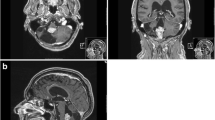Abstract
During a 20-year period (1964–1983), the authors managed 60 children with intracranial ependymomas. In 37 patients the tumors were located in the posterior cranial fossa, and in the remaining 23 they were supratentorial. The histological examination in 26 children revealed ependymoblastomas. The average duration of the clinical evolution was 4 months and 5 days in the supratentorial neoplasms and 3 months and 6 days in the subtentorial. Besides the intracranial hypertension, present in about 80% of the patients, specific localizing signs were seen in 70% of the children with subtentorial and in 40% of those with supratentorial tumors. Because of the growth pattern in posterior fossa ependymomas and despite the prevalence of histologically benign neoplasms, radical resection was accomplished in only 21.6% of the cases, as compared with 30.4% in supratentorial tumors. The postoperative mortality remains high: 29.7% in subtentorial tumors and 17.4% in supratentorial. The 1-year survival rate in subtentorial neoplasms was 70.3%, the 3-year survival 29.7%, and the 5-year survival 16.2%. The corresponding figures for supratentorial ependymomas were more favorable: 82.6%, 43.5%, and 26.1%, respectively. The most important factors for improving the outcome at the present time appear to be as radical a resection as possible, supplemented with postoperative radiotherapy and chemotherapy.
Similar content being viewed by others
References
Bloom H (1979) Recent concepts in the conservative treatment of intracranial tumors in children. Acta Neurochir (Wien) 50:103–116
Chin HW, Maruyama W (1982) Intracranial ependymoma: results of radiotherapy at the University of Kentucky. Cancer 49:2276–2280
Coulon RA, Till K (1977) Intracranial ependymomas in children. A review of 43 cases. Child's Brain 3:154–168
Dohrman GJ (1985) Ependymomas. In: Wilkins R, Rengashary S (eds) Neurosurgery, McGraw-Hill, New York, pp 767–771
Dohrman GJ, Farwell JR Flannery JT (1976) Ependymomas and ependymoblastomas in children. J Neurosurg 45:273–283
Goutelle A, Fischer G (1977) Les ependymomes intracraniens et intrarachidiens. Neurochirurgie 23 [Suppl 1]:54–73
Heiskanen O (1977) Intracranial tumors of children. Child's Brain 3:69–78
Heiskanen O, Lehtosalo J (1985) Surgery of cerebellar astrocytomas, ependymomas and medulloblastomas in children. Acta Neurochir (Wien) 78:1–3
Lapras C, Patet JD, Motolese C, Guyotat J (1987) Particular aspects of intracranial ependymomas in infancy: analysis of 21 cases (abstract). Child's Nerv Syst 3:308
Lejeune JP, Dhellemmes P, Dupard T, Gombelles G, Delansheer JM (1987) Les ependymomes intracraniens. Experience de 86 cas. Neurochirurgie 33:118–123
Lui M, Boggs J, Kidds J (1976) Ependymomas of childhood. Child's Brain 2:92–110
Marsh WR, Laws ER Jr (1987) Intracranial ependymomas. Prog Exp Tumor Res 30:175–180
Mork SJ, Loren AC (1977) Ependymoma. A follow up study of 101 cases. Cancer 40:907–915
Namer JJ, Pamir MN, Benli K, Erbengli A (1984) Les ependymomes intracraniens. Etude de 81 cas et comparaison avec la literature. Neurochirurgie 30:153–158
Oi S, Raimondi AJ (1979) Ependymoma. In: Pediatric neurosurgery. Grune & Stratton, New York, pp 153–158
Pierre-Kahn A, Hirsch JF, Roux FX, Renier D, Sainte-Rose C (1983) Intracranial ependymomas in children. Survival and functional results of 47 cases. Child's Brain 10:145–156
Renaudin JW, DiTullio MV, Brown WJ (1979) Seeding of intracranial ependymomas in children. Child's Brain 5:408–412
Rorke LB (1987) Relationship of morphology of ependymomas in children to prognosis. Prog Exp Tumor Res 30:170–174
Rubinstein LJ (1972) Tumors of the central nervous system. (Atlas of tumor pathology, ser 2, fasc 6). Armed Forces Institute of Pathology, Washington, DC, pp 32–34
Salazan OM, Castro-Vita H, Van Houtte P, Rubin P, Aygun C (1983) Improved survival in cases of intracranial ependymoma after radiation therapy. Late report and recommendations. J Neurosurg 59:652–659
Sato T, Shimoda A, Takahashi T, Kurokawa H, Ando M, Goto S, Takamura H (1984) Congenital anaplastic ependymoma: a case report of familial glioma. Child's Brain 11:342–348
Shuangshoti S, Panyathanya R (1978) Ependymomas. A study of 45 cases. Dis Nerv Syst 34:307–314
Tomita T, McLone DG (1987) Posterior fossa ependymomas in infancy and childhood (abstract). Child's Nerv Syst 3:308
Yates AJ, Becker LE, Sachs LA (1979) Brain tumors in childhood. Child's Brain 5:31–39
Author information
Authors and Affiliations
Rights and permissions
About this article
Cite this article
Undjian, S., Marinov, M. Intracranial ependymomas in children. Child's Nerv Syst 6, 131–134 (1990). https://doi.org/10.1007/BF00308488
Received:
Issue Date:
DOI: https://doi.org/10.1007/BF00308488




